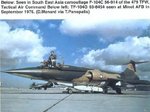CharlesBronson
Senior Master Sergeant
Damned near criminal. That's a serial killer cloaked with wings.
I wont say that but was a dangerous airplane for sure.
Pakistan took the F-104 into combat and I believe they lost 2, one non-combat. Spain operated the -104 and never lost one. NATO with the exception of Greece and Turkey had a loss rate of 1.81, if you factor in Greece and Turkey it rises to 2.14 - Now how about Japan? Their attrition rate average .068 through out their 20 operational history!!!
Well, Spain used only a reduced quantity ( I think 18 ) for a short time.
Probably the high atrition rate in the german Luftwaffe was caused by asking the aircraft/pilots to do task for who they were not properly designed/trained. However there is no doubt in my mind the the F-104 was quite unforgiving.




